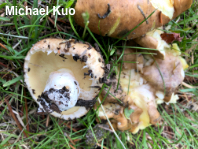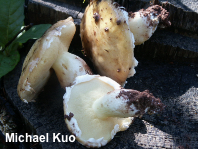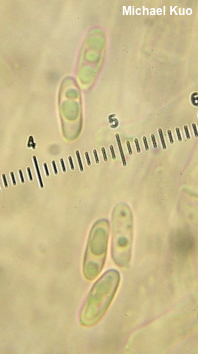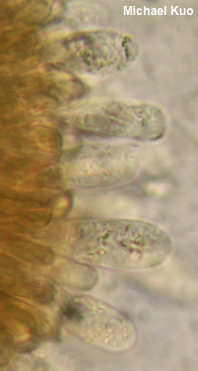| Major Groups > Boletes > Suillus > Suillus pseudobrevipes |

|
[ Basidiomycota > Boletales > Suillaceae > Suillus . . . ] Suillus pseudobrevipes by Michael Kuo, 11 January 2023 Found under lodgepole pine and other 2- and 3-needle pines in western North America, Suillus pseudobrevipes is, indeed, sort of like Suillus brevipes; its stature is usually a bit stocky, and the glandular dots on its stem are inconspicuous—so much so that they often appear to be missing, especially in young specimens. However, unlike Suillus brevipes, Suillus pseudobrevipes features a partial veil that can usually be detected as whitish tatters on the margin of the cap, and/or on the stem as a thin ring or a sheathing patch of white material at the stem base. Similar species include not only Suillus brevipes, but also Suillus glandulosipes—which, in its contemporary concept (á la Nguyen et al. 2016) includes what used to be known as Suillus albidipes and Suillus neoalbidipes. The veil in Suillus glandulosipes is confined to the margin of the cap and does not contact the stem (leading some to call it a "false veil"), so there is never a ring or sheath on the stem; also, the range of Suillus glandulosipes extends into eastern North America, and it is documented, not just with hard pines, but also with eastern white pine. Description: Ecology: Mycorrhizal with hard pines (those with needles in bundles of 2 or 3), especially lodgepole pine; growing alone, scattered, or gregariously; summer and fall; originally described from Idaho (Thiers & Smith 1964); distributed throughout western North America, in the natural range of lodgepole pine. The illustrated and described collections are from Colorado. Cap: 5–12 cm; convex becoming broadly convex; slimy when fresh; bald; brownish yellow to yellow-brown, fading to tan; the margin with white veil remnants. Pore Surface: Pale yellow, becoming darker yellow; not bruising; with 2–3 circular to angular pores per mm; tubes to about 1 cm deep; surface not boletinoid. Stem: 2.5–6 cm long; 1.5–2.5 cm thick; tapering slightly to apex; whitish to pale yellowish above; whitish to brownish yellow below; sometimes bruising brownish; glandular dots usually tiny and concolorous with stem surface (nearly invisible without a hand lens) when young, sometimes becoming brownish to brown as the mushroom matures; often with a fibrillose, whitish ring, but sometimes with merely a whitish sheathing over the base, or without any visible veil remnants; basal mycelium white. Flesh: White, or yellow above the tubes and in the stem; not staining when sliced. Odor and Taste: Odor slightly fragrant; taste not distinctive. Spore Print: Cinnamon brown. Microscopic Features: Spores 6–9 x 2–2.5 µm; boletoid-fusiform; smooth;hyaline to yellowish in KOH. Basidia 17–23 x 3–5 µm; clavate; 4-sterigmate. Cystidia in bundles; 28–45 x 4–8 µm; cylindric to clavate or subfusiform; smooth; thin-walled; hyaline to brown in KOH; often obscured by brown pigment globules. Pileipellis an ixocutis; elements 2–5 µm wide, smooth, hyaline to brownish in KOH. REFERENCES: H. D. Thiers & A. H. Smith, 1964. (Smith & Thiers, 1964; Thiers, 1975; Thiers, 1979; Smith, Smith & Weber, 1981; Both, 1993; Arora, 1986; Bessette, Roody & Bessette, 2000; Bruns et al., 2010; Klofac, 2013; Nguyen et al., 2016;Siegel & Schwarz, 2016; McKnight et al., 2021.) Herb. Kuo 08140303, 07261901. This site contains no information about the edibility or toxicity of mushrooms. |
© MushroomExpert.Com |
|
Cite this page as: Kuo, M. (2023, January). Suillus pseudobrevipes. Retrieved from the MushroomExpert.Com Web site: http://www.mushroomexpert.com/suillus_pseudobrevipes.html |



